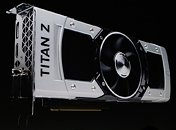Tuesday, March 25th 2014

NVIDIA Announces the GeForce GTX TITAN-Z
Here it is, folks, the fabled monster dual-GPU graphics card from NVIDIA, based on its GK110 silicon, the GeForce GTX TITAN-Z (sounds like "Titans"). The first reference-design graphics card to span across three expansion slots, the GTX TITAN-Z features a cooler design that's an upscale of the GTX 690, with a pair of meaty heat-pipe fed heatsinks being ventilated by a centrally-located fan. The card features a pair of GK110 chips, with all 2,880 CUDA cores enabled, on each. That works out to a total core count of 5,760!
That's not all, the two chips have 480 TMUs, and 96 ROPs between them; and each of the two is wired to 6 GB of memory, totaling a stunning 12 GB on the card. At this point it's not clear if the GPUs feature full-DPFP, but their SPFP totals 8 TFLOP/s. Display outputs on the card include two dual-link DVI, a DisplayPort, and an HDMI. According to its makers, the GTX TITAN-Z is the first graphics card that's truly ready for 5K resolution (5120 x 2700 pixels) on a single display head, for gaming. At US $2,999, the card costs thrice as much as a GTX TITAN Black, for twice its performance.
That's not all, the two chips have 480 TMUs, and 96 ROPs between them; and each of the two is wired to 6 GB of memory, totaling a stunning 12 GB on the card. At this point it's not clear if the GPUs feature full-DPFP, but their SPFP totals 8 TFLOP/s. Display outputs on the card include two dual-link DVI, a DisplayPort, and an HDMI. According to its makers, the GTX TITAN-Z is the first graphics card that's truly ready for 5K resolution (5120 x 2700 pixels) on a single display head, for gaming. At US $2,999, the card costs thrice as much as a GTX TITAN Black, for twice its performance.

122 Comments on NVIDIA Announces the GeForce GTX TITAN-Z
You can always just read the guys blog. Echelon Blog
FWIW, the same could be said of the GTX 690 - a card that I've seen more of as an Octane renderer than as a gaming card. Not saying the central radial fan and front exhaust are ideal, since it works against the natural airflow, but it doesn't seem to deter everyone
I can keep putting up the render rigs if you'd like just to prove that Echelon's isn't the only render rig in existence.
butthurt much that you need to prove something?
Might buy one of these if I win the powerball.
What boggles my mind is why call it a Geforce and not Tesla... Seems like Nvidia is trying to appeal to a much wider audience by marketing this card to Compute users as a cheap alternative to Tesla and gamers alike.
It might also be feeling pressure from Intel MiCs and AMD FirePro which have started providing competitive products stacks at a much lower price in that segment.
I believe your right though that the aim is more of a Student/Gamer/Novice
Providing examples to substantiate said possible usage scenarios.
Maybe I should just take a leaf out of your book and go with the resource-light,-no-thinking-required ad hominem attack that has zero content regarding the actual subject of thread.
Similarly, it's going to be far more common to see Titans in use, but there's going to be those occasions where its advantageous to use the Z.
There a few sites that try to use software tricks and PCB switching. You can get the software to make it show up as a Quadro and 1 or 2 features on certain commercial products but Its not the same as running a Quadro to a Geforce. Nvidia made sure of that.
Short list
* A lot of memory + ECC support.
* 64x antialiasing with 4×4 supersampling, 128x with Quadro SLI. The Geforce is limited to 32x, but supersampling is used only in certain 8x and 16x modes.
* Display synchronization across GPUs and across computers with the optional Quadro Sync card
* Support for SDI video interface, for broadcasting applications
* GPU affinity so that multiple GPUs can be accessed individually in OpenGL. This feature is available on AMD Radeon but not on Geforce.
* No artificial limits on rendering performance with very large meshes or computation with double precision
* Support for quad-buffered stereo in OpenGL
* Accelerated read-back with OpenGL. There are also dual copy engines so that 2 memory copy operations can run at the same time as rendering/computation. However, this is tricky to use.
* Accelerated memory copies between GPUs
* Very robust Mosaic mode where all the monitors connected to the computer are abstracted as a single large desktop.
The other primary differences are runtime validation (fewer errors in calculations) with Quadro, and better Viewport performance. The same applies to the difference between FirePro and Radeon. The video below compares a FirePro W5000 (basically a castrated HD 7850 - 25% fewer cores and texture address units, 50% slower memory) running rings around a Radeon.
Even if/when you can flash a gaming card into a pro card, you still can't get around the better runtime binning of the Tesla/Quadro/FirePro, so whilst you may save cash, it could come at the expense of visual artifacts in 3D renders or similar issues in other workloads.
But you may well have nailed it with your assumption, since 3K for higher end Tesla/Quadro cards is really not a lot of money.
You see, when you create a high level brand and expect companies in turn to pay top dollar for it, it actually makes sense to protect that brand.
A concept peeps here clearly struggle with.